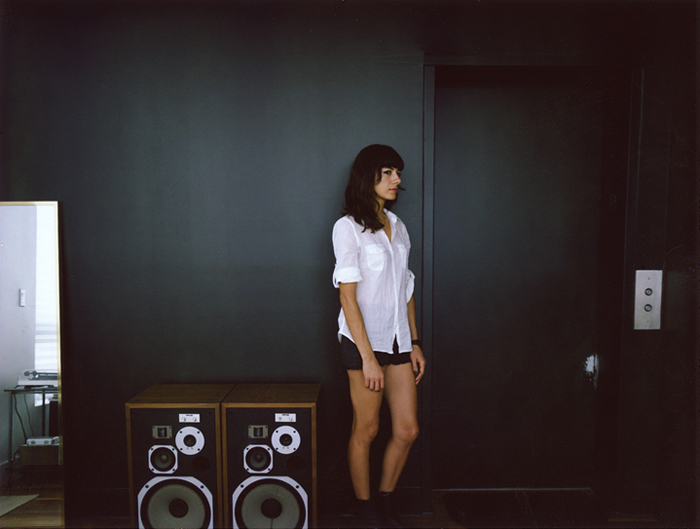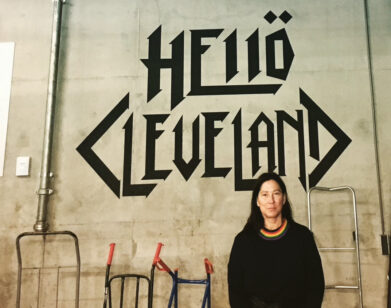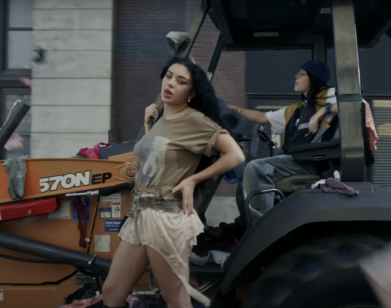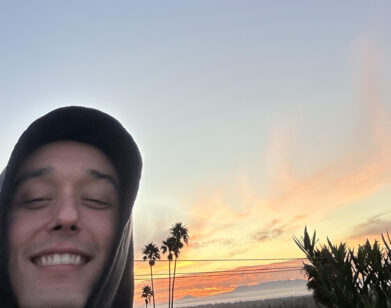Minimal Wave’s Big Splash

VERONICA VASICKA; PHOTO BY JASON SCHMIDT
Like many New York-bred kids of the ’80s, Veronica Vasicka spent her adolescence as a crate-digger, in search of something no one else was listening to (yet). She was a New Wave chick, but immediately drawn to synthesizers over guitars. Almost by accident, she began to cultivate interest in very specific genres. “I’d check out the imports and pick up random industrial vinyl and weird synthpop singles—things that I didn’t recognize, like Chris & Cosey and Throbbing Gristle. That was my early method of discovering music,” she remembers.
After graduating from Rhode Island School of Design with a degree in photography, she returned to New York, where she’s became immersed in the city’s nascent analog synth scene. In 2003, she co-founded the notoriously varied East Village Radio and gained acclaim for spinning a unique version of electronic music she called “minimal wave”—strikingly catchy arctic pop created on analog synthesizers by French, British, German, and Belgian acts in the early ’80s. Their names—Oppenheimer Analysis, Futurisk, Ruins, Martin Dupont—had remained mostly unfamiliar to anyone outside those territories, until Vasicka excavated their singles from the pop tombs and introduced them to a new audience 25 years later. These days, Vasicka’s still digging crates–but now she’s also filling them with records from her own highly regarded five-year old boutique label, Minimal Wave. Her first compilation, The Minimal Wave Tapes Volume 1, was released earlier this year and met with rave reviews. Vasicka herself has gained quite a presence in the industry as an influential tastemaker–next year, she’ll be featured in a Trolley coffee table book on notable New Yorkers alongside architect Richard Meier and artist Julian Schnabel.
As the popularity of vinyl records and synths continues to grow, the moment seems right to catch up with Vasicka, who explained how she became the ambassador for “vintage music’s future.”
COLLEEN NIKA: Let’s start at the beginning. How did you become involved with East Village Radio? What was your official role there?
VERONICA VASICKA: At the time, I was assisting restaurant owner, Frank Prisinzano. We discussed the idea of setting up the station next to his East Village restaurant, Lil’ Frankies. We managed to make that happen—and I became the station’s co-founder. My title was program director, although I was doing a lot of technical work, too. It was just me and one other person running the station for the first few years. We started out as a pirate station and decided to transition into online radio once we received the cease and desist order from the FCC. So, then I basically became responsible for its vision as an online station.
NIKA: How closely did you keep that vision to your own aesthetic?
VASICKA: I closely monitored it, but we made sure there was a lot of variety. There were a number of DJs–a lot of them were friends of ours. So, the programming was reflective of the tastes of the network of people behind the station. But I had my own show—Minimal Wave—and still do.
NIKA: What does that combined term “Minimal Wave” represent?
VASICKA: I was really into what is called “minimal synth”—music made strictly on analog synths, and also cold wave, basically a more synth-based version of European post-punk, at that point. So, I decided Minimal Wave was a good way to combine the minimal electronics aspect with the “wave,” where guitars come into play.
NIKA: What attracts you to this particular breed of music?
VASICKA: I was attracted to the aesthetics of these bands and also their specific histories. Some of these acts could have achieved the level of fame of Joy Division or other peers, but circumstances didn’t allow for it. I was looking at some old music charts in the magazine Vinyl–and all these songs had a brief moment in the Top 20 in various European countries. Then, they vanished. It’s really fascinating, and sometimes a bit sad.
NIKA: How did EV Radio help facilitate the birth of Minimal Wave Records?
VASICKA: I had been digging so much for my show–constantly finding fresh old material to play every week—that I ended up discovering all these obscure bands that no one had really heard here. It was very exciting to be able to play their records on the air for a new audience and be able to get instant feedback. A lot of people had strong reactions to the records and would ask,” Is this available to buy”? And the answer was “no, it’s not”. But then I realized: “Hmm, maybe it can be!”
NIKA: How do you find the bands you work with? What kind of research is involved?
VASICKA: Initially, it all went back to crate digging, going to record fairs and buying old LPs and tapes–and then examining the details of those releases. Then, I would figure out how to get into contact with the artists; many of these bands self-released their music through tiny labels and I’d try to find their contact info. But there’s also a great resource called CLEM (Canadian List of Electronic Music). It was an ’80s home-Xeroxed ‘zine filled with contact information for obscure synth acts. That ‘zine help spur a lot of synth collaborations between international acts that never even met–not unlike blogs, but through snail mail. It also proved very helpful to me tracking down these acts two decades later.
NIKA: What led to you choose Oppenheimer Analysis as the first band to received an official Minimal Wave re-release?
VASICKA: I had been DJing a dance night in Brooklyn and witnessed the response people had to “The Devil’s Dancers”—Oppenheimer’s one hit song. All these young people were dancing to this amazing song, completely unaware of whether it was current or not. It was from 1982, but sounded very current. It made sense that a physical record should exist for this song again. It seemed the obvious choice to represent what Minimal Wave was going to be.
NIKA: What are some of the challenges of reissuing these works?
VASICKA: Well, in many cases, these acts released songs on tape in very limited quantities–and the quality wasn’t very good. So, when I reissue these songs, I also re-master them. With Oppenheimer Analysis, it turned out that the band still had the master tapes. So, Martin from the band and I baked the tapes to restore the quality.
NIKA: You baked them?
VASICKA: [Laughs] Yes–it’s a weird technique but it works. If you bake tapes at a certain temperature–I think it’s 130 degrees–something happened to the magnetic particles, so you can restore them. The key is to do the transfer to digital while it’s still warm. If it’s done right, the new digital version will actually improve upon the quality of the original. If you do it wrong, though, the tapes will melt!
NIKA: What minimal synth or coldwave band do you think, in retrospect, had the best chance for commercial success?
VASICKA: I think Oppenheimer Analysis had the most accessible material for commercial success. Martin Dupont, Deux, Linear Movement, Moderne and Stereo held a lot of potential as well.
NIKA: Why do you think those subgenres have recently experienced a revival of interest?
VASICKA: I think there are several reasons for this, one being the recent accessibility of rare vinyl and cassette music via blogs, as well as the digital backlash which is driving more people to crave the tangible–most of these releases are hand-numbered vinyl editions, which adds another level to the listening experience. They can listen to an LP and it’s there for them to look at, examine its cover art, and hold whilst buying and downloading music in digital form remains such an ephemeral experience.
NIKA: Do you feel like you’re giving these bands a new life?
VASICKA: Maybe a bit! It’s a very satisfying feeling for everyone involved–for me, the artists, and the audience.
NIKA: What do you think of contemporary bands that have been mimicing this style?
VASICKA: I like some of them. I like the ones that are trying to evolve it into a new direction–who can do bring it into 2010. I don’t really like the bands that think they’re still in 1982. It’s boring. When retro sounds are combined with a modern approach, it can be great. I really like Innergaze—I mastered their last record. And I love Led Er Est, Xeno and Oaklander, and Light Asylum.
NIKA: How are you able to fund a label with such a niche audience?
VASICKA: You’d be surprised–those records sell really well. It’s somehow worked out that I create a product that caters to a specific customer, who are willing to pay for it!






